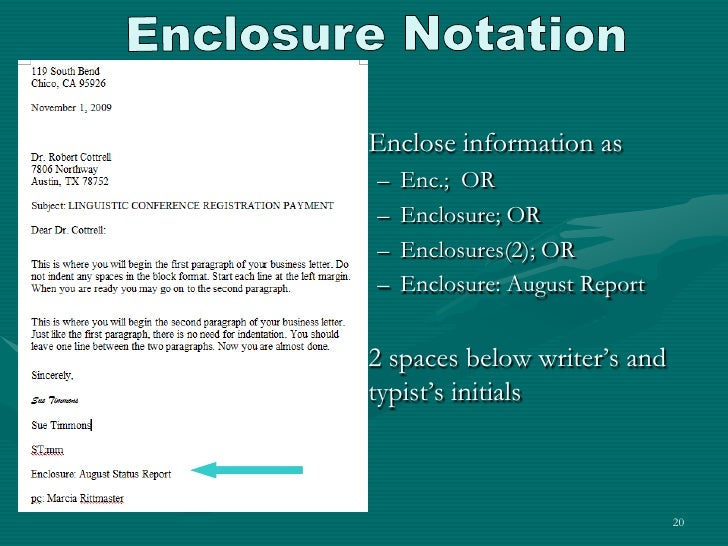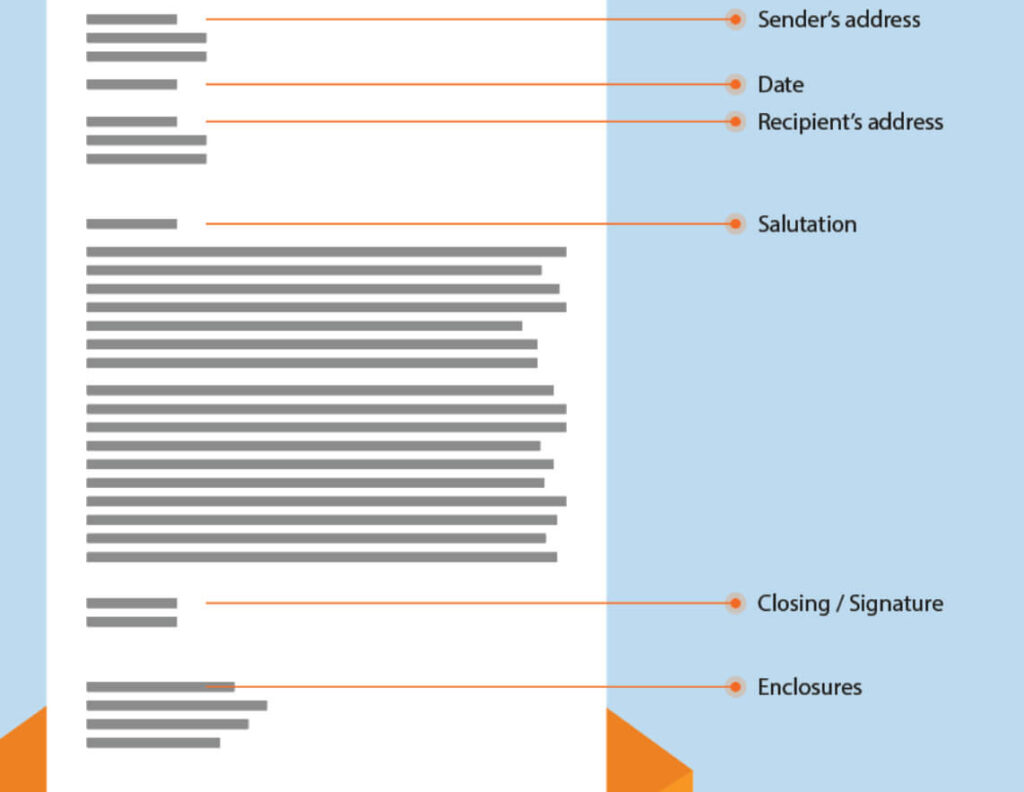Enclosure notations are a standard part of formal business letter writing that serve an important purpose yet are often confusing for many professionals. In this comprehensive guide, I’ll explain exactly what enclosure notations are where they go in a business letter, examples of how to write them, and tips for effectively using enclosures to enhance your professional business communications.
What is an Enclosure Notation?
An enclosure notation indicates that additional items have been included along with a traditional printed business letter. For example, an enclosure notation could indicate that brochures, reports, presentations or other supporting documents were physically mailed with the letter.
Even for email communications an enclosure notation can still be useful to indicate that electronic file attachments were included with the message.
The enclosure notation serves as a reminder to the recipient that supplementary materials were provided in addition to the letter itself. This helps ensure the recipient is aware of and reviews all the relevant items you sent.
Why Use Enclosure Notations?
There are several key reasons why properly including enclosure notations is considered an important business letter writing practice:
-
Alerts recipient – Makes clear that additional documents were included, so the recipient knows to look for them.
-
Tracks attachments – Creates a record of what was attached, which could be useful for legal/compliance reasons.
-
Avoids confusion – Prevents mistakes if attachments get separated from the letter during mailing.
-
Looks professional – Using proper business letter formats enhances your credibility and brand image.
-
Provides details – Allows listing specifics about each included document for clarity.
Overall, enclosure notations help ensure your business communications are clear, professional and minimize the chance of confusion on the part of recipients.
Where Do You Put Enclosure Notations?
For a traditional printed letter, the enclosure notation is included at the bottom of the letter, 3 lines below your signature block. It should be the second to last element, followed only by the typist’s initials (if included).
Here is an example showing where the enclosure notation fits within overall business letter format:
![Business letter format][]
For email communications, the enclosure notation would simply be inserted at the very bottom of your message body, before your name.
How Are Enclosure Notations Written?
The most common enclosure notation styles are:
- Enclosures (2)
- Encl: (singular enclosure term)
- Enclosure: (lists each item)
Some examples:
- Enclosures (3)
- Encl: Product brochure
- Enclosure: Market research report, 3rd quarter sales deck
You can choose to just indicate the number of enclosures in parentheses, or provide specifics about each item. I recommend including details whenever practical, as it provides helpful context for the recipient.
Aim to keep the notation brief and concise. Avoid attaching so many items that the notation becomes excessively long. Typically no more than 3-5 enclosures is ideal.
Sample Business Letter with Enclosure Notation
Below is an example letter format with an enclosure notation:
July 5, 2023
Alex Johnson
Director of Operations
ABC Company
123 Main St.
New York, NY 10001
Dear Mr. Johnson:
Thank you for taking the time to discuss partnership opportunities between our companies at last week’s trade conference. It was a pleasure speaking with you.
As discussed, I’ve attached documents outlining a proposed plan for ABC Company to manufacture and distribute our company’s new product line. Please review the plan and provide your thoughts on next steps.
Sincerely,
Maya Smith
President
XYZ Corporation
Enclosure: Manufacturing plan, Distribution strategy, Market research report
Tips for Using Enclosures Effectively
Follow these tips when using enclosures for maximum impact:
- Only attach documents that directly support your main message. Don’t overwhelm recipients with unnecessary enclosures.
- Summarize the purpose of each enclosure within your letter content when possible.
- Ensure you actually include every document listed in the notation! Double check before sending.
- For physical mailings, only enclose hard copies of documents if specifically requested by the recipient. Otherwise provide digital attachments.
- For email, use descriptive file names that align with the enclosure notation details.
- Follow up if you don’t receive a response after a reasonable time. Check if they received all attachments or had issues accessing them.
Other Common Business Letter Notations
In addition to enclosures, there are some other abbreviations you may see at the end of formal business letters:
- CC – Carbon copy. Lists other recipients getting copied on the letter.
- BCC – Blind carbon copy. Lists recipients discreetly copied without the main recipient being informed.
- PC – Photocopy. A less common alternative to CC.
- Typist Initials – Identifies who typed the letter, listed after the enclosure notation.
These other notations serve purposes similar to the enclosure by clarifying distribution details and letter creation specifics.
Should You Use Enclosure Notations for Email?
While enclosure notations originated for mailed communications, they can still serve a useful purpose when applied properly in email.
However, some experts argue that with email, attachments are clearly displayed and identifiable in the message interface along with the cover message text, reducing the need for notation.
My personal take is that while not always essential for casual communication, enclosure notations can still provide clarity for formal business emails with critical attachments, especially those going to less tech-savvy recipients.
Mastering professional business letter writing techniques like proper enclosure notations might seem like a minor detail, but getting the basics right goes a long way towards building credibility and trust with recipients.
So the next time you are drafting an important outward-facing communication, take a moment to thoughtfully consider how a well-structured enclosure notation could enhance the effectiveness of your message.

What Do the Initials at the Bottom of a Business Letter Mean?
Initials included at the bottom of a business letter are called typist’s initials. Some companies require them so that they know who actually typed the letter versus who composed it, in order to determine who is responsible for typos, misspellings and other mistakes that took place when the letter was produced.
Omitted details in a business letter can make a difference, so it’s important to know who typed the letter if an item that the sender wanted in the letter does not end up in the finished document.
The typist’s initials are one of the last elements of the business letter. They include the initials of the letter’s writer in all caps, followed by a slash mark or colon, and then the initials of the typist in lower case. For example, if William Shakespeare typed a letter for his manager Virginia Woolf, the typist’s initials would be: VW/ws.
The typist’s initials, of course, are not a required element if the signer of the letter also typed it.
Where Is the Enclosure Located?
The enclosure in a letter goes near the bottom of the page, three lines below your signature or one line below the typist’s initials, in the case of a regular business letter.
Out of the seven basic parts of a business letter, the enclosure notation is the last. Sections that come before the enclosure letter notation include the:
- Sender’s address
- Date
- Recipient’s address
- Salutation
- Body
- Closing/signature
Below is an example of a business letter format with enclosures at the bottom:

Enclosure Notations-Unit 6.avi
What is an enclosure notation in a letter?
Enclosure notations tell or remind the letter’s recipient that you included other documents and items in your correspondence. Some notations also show what those items were, depending on if you want to include that amount of detail. You place them at the bottom of your correspondence for standard business letters, professional emails and memos.
Why is an enclosure notation important?
An enclosure notation lets the reader know other documents are enclosed or attached within the letter or email in question. A business letter with enclosures usually has the enclosure notation as both a practical backup and a formality. So, why is an enclosure notation important anyway?
What is an enclosure in a letter?
Unlike regular attachments that expand on the message of a letter, enclosures stand alone. For example, a resume provided with a cover letter would be an enclosure. Enclosures are noted within a business letter or email with an enclosure notation informing the reader or recipient of the additional material.
Where is the enclosure in a business letter?
The enclosure in a letter goes near the bottom of the page, three lines below your signature or one line below the typist’s initials, in the case of a regular business letter. Out of the seven basic parts of a business letter, the enclosure notation is the last. Sections that come before the enclosure letter notation include the: